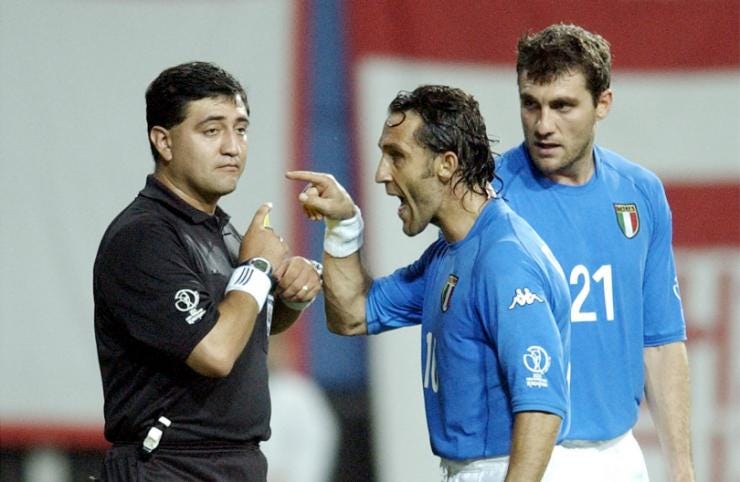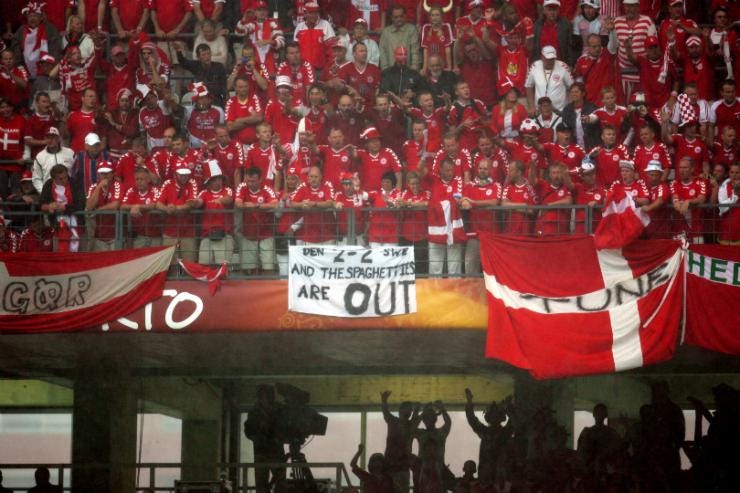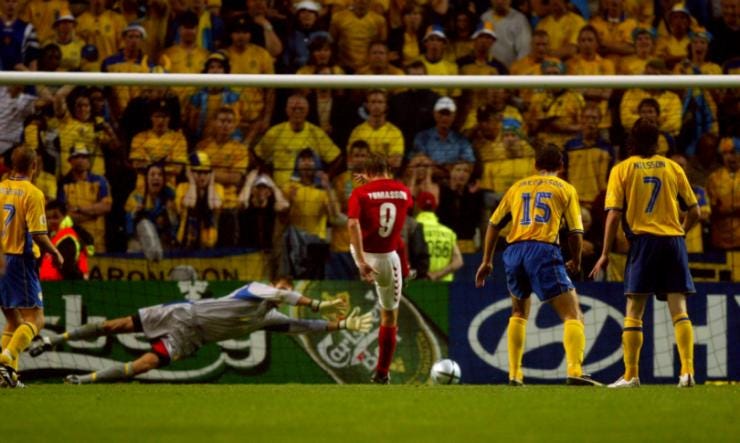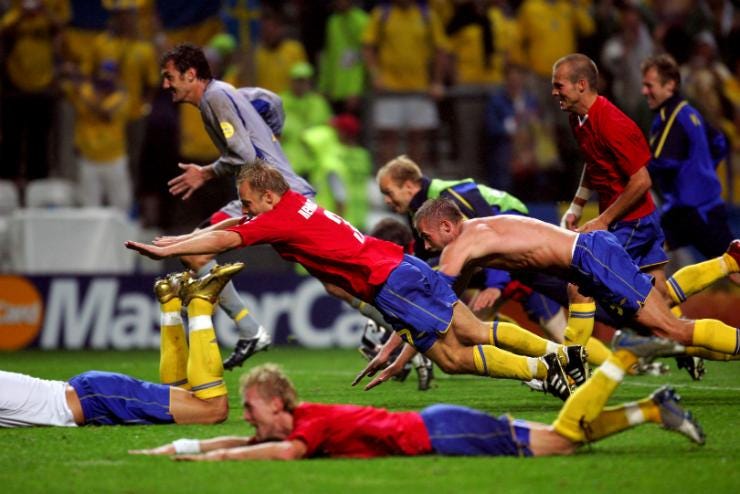On this day in the Euros, June 22: Scandi “stitch-up” eliminates Italy
What happened when two Scandinavian sides could squeeze out Italy by playing out a 2–2 draw? Why, a 2–2 draw, of course… but was it fixed?
June 22 has been a big day for Euro penalty shootouts: the Dutch lost to Denmark in 1992 and France four years later, while Spain lost to England in 1996 but beat Italy in 2008. However, today’s story concerns another way that Italy were eliminated — much more controversially, considering they weren’t even present.
First, let’s pop back a bit. Until Spain 82, the final group games weren’t held simultaneously; this allowed the teams who played last to know what they needed to do. And in Group 2, it allowed West Germany and Austria to calculate that a 1–0 German win would see them both go through at the expense of surprise package Algeria.
Uncoincidentally, that’s exactly what happened: after taking an early lead through Horst Hrubesch, West Germany sat back and so did Austria. The stitch-up was so obvious that the Spanish crowd screamed their disapproval, a German fan burned his own country’s flag, a German commentator refused to continue his duties, and an Austrian reporter asked viewers to turn over. It became known as the ‘Disgrace of Gijon’.
Since then, final group games have been simultaneous, but that doesn’t always create an absence of mutually satisfactory results. Which is where our irate Italian friends come in.
For those in peril at C
Euro 2004’s Group C was tight, with Italy, Sweden and Denmark fighting for two qualification spots and Bulgaria the whipping boys. After the first two games, both Scandinavian teams had beaten the Bulgarians and drawn with the Italians; with head-to-head taking preference over goal difference, that meant that even if Italy annihilated Bulgaria, a high-scoring draw — say, 2–2 or more — would see the Scandis scamper through.
The Italian media weren’t slow to note this possibility; they were still fuming over the manner of their exit from the 2002 World Cup, in a hugely controversial 2–1 loss to co-hosts South Korea refereed by Byron Moreno — later investigated by FIFA, suspended for 20 matches by Ecuadorian authorities and arrested at New York’s JFK airport with 6kg of heroin in his underpants.

Denmark boss Morten Olsen was offended: “That’s ridiculous. Don’t speak about that,” he told a press conference. “We are honest people. We are going out to win the game and that’s all. They [Italy] can speak about these things but not Denmark and Sweden. We are going honestly for a result.”
The insistent Italian press corps provoked Tommy Soderberg into a physical response, the Sweden co-coach banging a table and thumping his chest while asserting “We say it again, we will not make a deal with Denmark. It’s about passion and dignity.”
Soderberg’s sidekick Lars Lagerback reached for a literary reference: “Machiavelli might have been Italian and Italians might like to think in a Machiavellian way, but it would not be possible to play for a 2–2 draw against Denmark and I don’t think it will end 2–2 — that is a very unusual result.”

June 22, 2004
The Swedes made three changes in midfield. Kim Kallstrom made his first start, in the №10 role behind Zlatan Ibrahimovic and Henrik Larsson, with Mattias Jonson coming in on the right and Fredrik Ljungberg remaining on the left.
It certainly wasn’t a defensive team, considering defeat might well send the Swedes crashing out. The Danish formation was slightly more conservative, a 4–2–3–1 showcasing the playmaking talents of Milan’s Jon Dahl Tomasson.
And the Danes looked the more threatening early on in wet and windy conditions at Boavista’s stadium in Porto, Tomasson benefiting from an Andreas Jakobsson slip to send in Jesper Gronkjaer; the winger, who within a month would be one of the first players to leave Chelsea under new manager Jose Mourinho, could only slice into the side-netting.
Opting instead to paddle his own canoe, Tomasson gave Denmark the lead just before the half-hour. Given a flick-on by targetman Ebbe Sand 25 yards out, he let the ball bounce and lofted it over the stranded goalkeeper Andreas Isaksson. One goal down, three to go?
Well, Sweden took their turn a minute after half-time, through the much easier route of a penalty: Larsson chased Olof Mellberg’s through-ball, Thomas Sorensen upended him and the 32-year-old striker — who later that month would move from Celtic to Barcelona — sent Sorensen the wrong way from the spot.
Permutations
It’s worth noting that at this point, Italy were losing to Bulgaria anyway — although they would soon equalise through midfielder Simone Perrotta, for whom there is a statue in the Mancunian suburb of Ashton-under-Lyne (he was born there, where his parents ran a pub before returning to their Italian roots).
Back in Porto, the Scandinavian face-off continued. For all the Italian fears of a Nordic deal, it’s worth remembering that these nations are great rivals who have fought dozens of wars over the centuries. That said, there are clear cutural links between the broderfolk (brother peoples) — the southern part of Sweden used to be part of Denmark, and the opening in 2000 of the Oresund Bridge between Copenhagen and Malmo had helped bring the countries closer together.
Even so, they were still trying to stick the ball in each other’s net. Larsson lashed a low drive just wide of Sorensen’s post as the Swedes upped a gear, but it was the Danes who would retake the lead on 66 minutes.

It came in chaos from a corner. Sub Kasper Bogelund’s flag-kick was nodded clear but only as far as Christian Poulsen, 25 yards out, who obviously hammered it back goalwards. It pinballed off two players and landed at the feet of the last man Sweden would choose to leave loitering unmarked on the penalty spot — Tomasson, who smashed it past Isaksson.
Advantage Denmark. Thomas Gravesen was running the game in midfield, prompting Sweden’s Anders Andersson to shout “Come on, bloody hell, give us a break now” — to which the bald Everton midfielder responded “Yes, but then you have to at least go forward.”
It was hardly earth-shattering tactical advice but it worked. Winger Christian Wilhelmsson’s jinking run from the flank to the six-yard box ended in a fizzed cross which Sorensen failed to hold and Mattias Jonson hooked in the equaliser with two minutes left on the clock.
The result rendered useless Antonio Cassano’s injury-time winner against Bulgaria. The Italians complained bitterly; Milan’s baldy bigwig Adriano Galliani moaned “We got as many points as the players who are blond and beautiful. But we are darker and not as beautiful.”
However, the stats didn’t really back up the allegations: Denmark had 16 shots to Sweden’s 15, Sorensen making four saves to Isaksson’s five — not exactly the sort of pattern you’d expect in teams manufacturing a fix.
True, the Scandinavian nations celebrated simultaneously, but even here there was a suitable discomfort among some players. When Sorensen ran up behind his Aston Villa team-mate Marcus Allback and lifted the Swedish sub into the air in exultation, the horrified Allback shouted “Let me go, this is embarrassing”.

What happened next
Both Scandi sides fell at the next hurdle. Denmark were hammered 3–0 by the Czechs, while Sweden managed to lose on penalties to the Dutch, who’d never won a shootout before.
Italy became more concerned with provable dark dealings when the Calciopoli scandal broke in May 2006. It didn’t stop them winning that summer’s World Cup, although Adriano Galliani was banned from all football activities for five months. Don’t worry, he’s back now.
Originally published by FourFourTwo on June 21, 2016.






